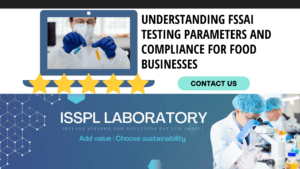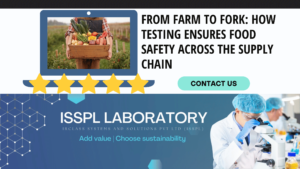An Overview by Team ISSPL - Analytical Testing Laboratory in India
ToggleEggs are among the most nutritious food items for non-vegetarians in the world. Many only consume eggs as part of their protein-filled diet. Eggs are the best diet companions for children and adults, and they work aptly as a balanced diet constituent. Eggs are wholesome foods with the highest biological protein value. The composition of egg whites and yolk plays a crucial role in sufficing human nutrition.
Eggs contain –
- Lipids
- Minerals (including zinc, iron, and selenium)
- Vitamins (such as B2, B12, D, and E)
Every part of an egg, including – the egg shell, yolk, and egg white, is essential for health and body development in children and adults.
Quality maintenance – Farm to fork
Eggs are part of the highly perishable food community. One must take sufficient care of the egg’s quality to ensure optimal health benefits to the consumers. Retaining the best quality of the egg from farm to fork is a challenging aspect. But one can ease the worries with the best quality testing steps. Identify the critical quality specifications and follow the ideal ways to assess the overall food grade of the eggs and their derived products.
The quality-based norms regulated on eggs and poultry-based products need careful understanding and management. The leading industrial brands and organizations take sufficient care to meet the quality control features. The testing and rigorous analytical drills help them remain one step ahead in the competitive food market. Thus, the mechanisms and quality testing steps for farm-to-fork programs are vital to note.
One can find several products derived from egg components. Processing the eggs into various edible components involves dynamic stages. It includes –
- Collection
- Food Handling
- Shell washing
- Component grading
- Candling
- Quality testing
- Pasteurization
- Shell Preservation
- Product freezing
- Storage and preservation
Quality determining factors – Know them rightly.
Eggs are biological products, and thus, the chances of contamination are higher. Every second, millions of eggs get contaminated or rotten. The egg products are also unsafe in more ways than one. Manufacturers and suppliers in the food industry must take strict actions to deliver high-quality eggs and egg products to the consumer base. The quality maintenance steps are crucial to ensure sustainable economic viability in the food trade industry.
The different quality determinants in an egg help state the suitability of the product in the commercial consumer sector. It includes shell strength, albumen consistency, egg measurement, and yolk pigmentation. These are the prime quality factors that make a visible difference. But there is more. Acknowledging quality measures like – food safety, hygiene, and egg freshness needs highlighting.
The quality of an egg is subject to –
- External factors of the egg, like – shape, texture, shell cleanliness, pigmentation, weight, etc.
- Internal factors of the egg, like – position of egg yolk, shell porosity, measurement of the air cell, albumen, etc.
The globally acclaimed food standard agencies have defined the quality norms and regulations to safeguard consumer health from dynamic health risks. The health threats can be numerous and diverse. It can even be the presence of pesticides on eggs. As eggs are popular diet choices across the world and egg-based food products are widespread, one needs careful quality management. The components of the egg can also pose allergies. The egg-based proteins may cause allergic reactions, and thus, quality checks are indispensable. The objective of the egg quality test is to ensure a 100% guarantee of the goodness of the albumen component.
Egg quality system – Why is it essential?
A high-quality egg must have a firm and round yolk. The thick albumen and thin outer albumen exhibit the quality aptly. The analytical tests include thorough data collection and sampling. All these help obtain an accurate measurement. With the new-age testing devices, it is convenient to magnetically locate the quality inconsistencies. It facilitates the process of quick removal of rotten or inferior-quality eggs. Data from the test results determine the fate of the supplier batch. Hence, one can understand the criticality of conducting the quality testing steps on the eggs.
Prevent health threats and contamination – Know the pathogens
| SALMONELLA | Salmonella spp. are the most common bacterial pathogens promoting foodborne illnesses. The symptoms of salmonellosis include – diarrhea, abdominal cramps, and fever. All these happen after eating the contaminated egg within 72 hours. Salmonellosis can trigger Salmonella-induced chronic conditions in adults, like – aseptic reactive arthritis and Reiter’s syndrome. Older adults and infants with weakened immune systems can also be affected by the pathogen contamination in the egg. Salmonella spp. contamination is common in egg products for under-processing. It can get contaminated in the post-processing environment via physical contact, additives, and insect vectors. |
| LISTERIA MONOCYTOGENES (Lm) | Listeria Monocytogenes is a bacterium that can impact egg quality adversely. The bacteria are found in moist environments, humid soil, and decaying vegetation. It contaminates the egg and can trigger a serious infection upon its consumption. The infected egg and its products are toxic for adults and children. Listeria monocytogenes can also cross-contaminate food as a result of inferior sanitation, inappropriate equipment maintenance, product mishandling, etc. |
Key takeaways
Now you know the prime aspects related to egg quality checks. The egg samples collected for lab analysis need to be transported at optimal temperature and pressure. Otherwise, it can impact the composition and quality. It is vital to transport the eggs in well-designed and protective cartons or egg cases before analyzing them at the lab.
The foremost step is to identify the egg samples and analyze them visually. These are prime requisites for Biuret’s Lowry’s, and Kjeldahl methods. Experts at the laboratory can manage the quality control requisites and perform the test flawlessly. Obtain expert advice on the analytical testing programs, and checklist for food hygiene and allergens. All these are vital to strengthen the quality checks for eggs and the derived products.
Trust the offerings of IRCLASS Systems and Solutions Pvt Ltd (ISSPL) laboratory for food testing and egg quality assessment. Obtain accurate analytical test reports on the egg quality of the best-in-class equipment solution.







